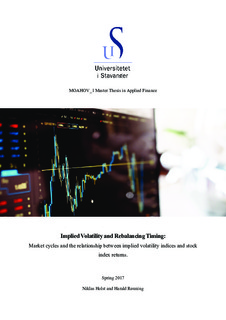| dc.contributor.advisor | Molnar, Peter | |
| dc.contributor.author | Holst, Niklas | |
| dc.contributor.author | Rønning, Harald | |
| dc.date.accessioned | 2017-09-26T12:54:38Z | |
| dc.date.available | 2017-09-26T12:54:38Z | |
| dc.date.issued | 2017-06-14 | |
| dc.identifier.uri | http://hdl.handle.net/11250/2456818 | |
| dc.description | Master's thesis in Finance | nb_NO |
| dc.description.abstract | This paper studies market timing based upon the level of the VIX and compares VIX based portfolio rotations with modern rebalancing practices. The thesis analyses the outcomes of the different rebalancing and trading strategies, and compare them through different performance measures. The study finds that on average, rebalancing strategies based on the level of the VIX does not have significant positive returns compared to the standard dynamic rebalancing scheme that are used today by nearly every professional mutual fund manager. | nb_NO |
| dc.language.iso | eng | nb_NO |
| dc.publisher | University of Stavanger, Norway | nb_NO |
| dc.relation.ispartofseries | Masteroppgave/UIS-SV-HH/2017; | |
| dc.subject | økonomi | nb_NO |
| dc.subject | administrasjon | nb_NO |
| dc.subject | volatility | nb_NO |
| dc.subject | rebalancing | nb_NO |
| dc.subject | index | nb_NO |
| dc.subject | finans | nb_NO |
| dc.title | Implied Volatility and Rebalancing Timing: Market cycles and the relationship between implied volatility indices and stock index returns. | nb_NO |
| dc.type | Master thesis | nb_NO |
| dc.subject.nsi | VDP::Samfunnsvitenskap: 200::Økonomi: 210 | nb_NO |
